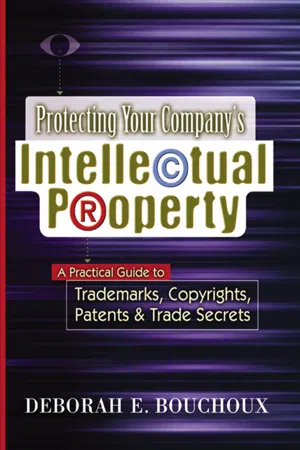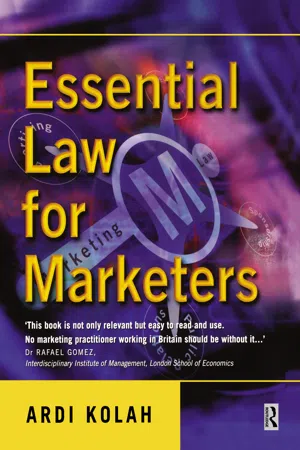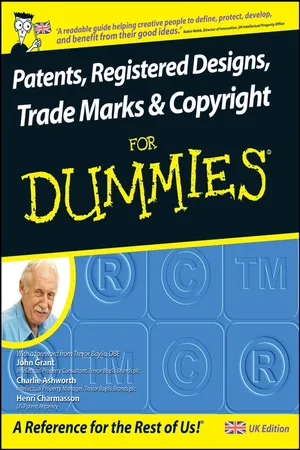Technology & Engineering
Trademarks
Trademarks are distinctive signs, symbols, or logos used to identify and distinguish the goods or services of a particular company from those of others. They play a crucial role in protecting a company's brand and reputation, as well as in helping consumers identify and choose products or services. Trademarks can include words, names, symbols, or devices, and are legally protected to prevent unauthorized use by others.
Written by Perlego with AI-assistance
Related key terms
Related key terms
1 of 4
Related key terms
1 of 3
5 Key excerpts on "Trademarks"
- eBook - ePub
First to File
Patents for Today's Scientist and Engineer
- M. Henry Heines(Author)
- 2014(Publication Date)
- Wiley-AIChE(Publisher)
AvidAir also argued that the current update should not be afforded trade secret status since it contained only a small amount of information that was not also available from prior (nonconfidential) updates and that the new information offered no technical advances over the old. The court responded by drawing attention to the fundamental difference between patents and trade secrets, which is that patent law awards property rights based on novelty and nonobviousness, while trade secret law governs commercial ethics by recognizing rights that are based on economic value and secrecy. A trade secret thus derives its value from being a secret rather than from the merit of any technical improvement it may contain. As a result, Rolls-Royce was awarded $350,000 in damages and a permanent injunction requiring AvidAir to discontinue repairing and overhauling Model 250 engines and to return the protected documents to Rolls-Royce.11.2 Trademarks
A trademark is a commercial source identifier and takes the form of a word, symbol, or device that is identified with the goods of a particular manufacturer or distributor and that distinguishes those goods from the goods of other manufacturers or distributors. Service marks and trade names are also commercial source identifiers and are used in ways analogous to Trademarks. Like a trademark, a service mark associates a service with the service provider. Similarly, a trade name is the name of a corporation or other business entity that symbolizes the identity and reputation of that entity aside from the merits of specific goods or services that the company provides. Trademarks, service marks, and trade names are thus valuable forms of IP, conferring property rights and protection for a range of subject matter that differs considerably from that of patents. For convenience, the term trademark is used here in a collective sense to include all three—Trademarks, service marks, and trade names.11.2.1 Choosing a Trademark
Terms and symbols for use as Trademarks are generally chosen at the early stages of developing a corporate identity or a marketing strategy for a product or service. The best marks are those that have market appeal but are also both available for use and protectable. To be available for use, the mark must be one that is not similar to a mark already in use by another, and to be protectable, a mark must be of the type that is enforceable against infringers. - eBook - ePub
The Balanced Engineer
Essential Ideas for Career Development
- IEEE(Author)
- 2018(Publication Date)
- CRC Press(Publisher)
You probably already know that a trademark is the legally protected name of a product. Similarly, a service mark is essentially the same thing as a trademark, but it is used for a service. Trademarks are a bit more complicated than just being simple product names. The rules that dictate whether or not a given name can act as a valid trademark are somewhat mysterious to the uninitiated.Although Trademarks are now firmly a part of “intellectual property,” their origins are somewhat different than those of copyrights and patents. In their oldest and simplest form, Trademarks appeared as a mark or symbol that a craftsman or manufacturer placed on his goods. Such marks appear on goods produced as long ago as several millennia before the birth of Christ. It is not uncommon to find marks on jewelry and stone work from Mesopotamia and Ancient Egypt. Both the Greeks and Romans used distinctive “brand marks” on the seals of amphorae of wine.PROTECTION FOR THE PUBLIC
As modern capitalism developed during the Renaissance and following periods, many businesses began to place some sort of trademark on their goods. The motivation for doing so was probably pride in workmanship. Moreover, Trademarks represented a particular business’ products to its customers.Today, it is generally recognized that Trademarks have at least two important functions. First, they protect the public from poor-quality goods by ensuring that a given product can be recognized readily. Second, the manufacturer who owns a particular trademark is given a means to protect the public goodwill he builds for products through efforts to maintain quality and through advertising.PROTECTION FOR THE BUSINESSES
Manufacturers of high-quality goods develop goodwill or an anticipation of quality from their loyal consumers, who associate a given trademark with a certain type and quality of product. Almost everyone expects that the brand-name products will be more expensive. This is partially because the manufacturer has spent money improving the quality of his product and seeks to recoup that expenditure. It is also partially because brand-name products are usually more heavily advertised, and that expense must also be recouped. Lastly, the manufacturer charges more because he knows that the market will bear a higher price. That is, many consumers are willing to pay a premium to eliminate the uncertainty that surrounds purchase of an unknown product. - eBook - ePub
- Deborah E. BOUCHOUX(Author)
- 2006(Publication Date)
- AMACOM(Publisher)
The names, designs, slogans, or other devices by which a company identifies its products and services can be among the most valuable assets a company owns. Most American consumers can readily fill in the blank in the following slogan: “Just Do ___.” Nearly all consumers can easily hum the tune that accompanies the words “You Deserve a Break Today.” Just a glimpse of aqua and orange at the edge of a highway lets consumers know there is a Howard Johnson’s nearby. How did these businesses achieve such national and even international recognition for their goods and services? By selecting and then vigorously protecting their Trademarks. In fact, the Coca-Cola Company estimates the value of its portfolio of Trademarks at more than $30 billion.The Term Defined
A trademark is a name, symbol, device, or combination thereof that identifies and distinguishes one’s goods and services from those of another. Technically, a trademark is used to identify a good or product, such as WINDOWS® or CAMRY®, whereas a service mark is used to identify services, such as H & R BLOCK® or FLY THE FRIENDLY SKIES OF UNITED®. In practice, however, most people use the term trademark to refer to both goods and services.How Trademark Rights Arise
Trademark rights arise through use of a mark. Thus, the owner of a small car repair service in Kansas City operating as TENDER, LOVING CAR has rights in and to this mark against any later users who use a confusingly similar mark in Kansas City and a reasonable area of expansion beyond, even if the owner has not registered the mark with any federal or state agency. Rights to Trademarks are not contingent on registration, but registration does afford the trademark owner certain advantages. For example, a federal registration of TENDER, LOVING CAR would protect the mark nationwide against later confusingly similar uses.What Marks Are Protectable
Not all names or slogans qualify for protection. A mark cannot be generic, such as SODA for a beverage or TV for a television. Furthermore, marks that merely describe the goods or services offered under the marks generally are not protectable. For example, the name Tax Preparation Software for a software program that enables its users to prepare their tax returns probably would not be protectable.Trademark Registration
If a mark is used in interstate commerce, its owner should seek a federal registration for it to achieve the greatest protection for the mark. An application for registration is filed with the U.S. Patent and Trademark Office (PTO), located in Washington, D.C. The filing fee is $325, and it generally takes about a year for the registration to issue. Thereafter, the PTO requires periodic filings to ensure that the mark is in use. Marks not in use become available to others. Once the mark is registered with the PTO, its owner can use the federal registration symbol ® to identify that fact, although use of the registration symbol is not required, and alternative forms of registration notice may be used. - eBook - ePub
- Ardi Kolah(Author)
- 2012(Publication Date)
- Routledge(Publisher)
Certain goods will be sold under a variety of Trademarks. For example, ‘Ford’ is a trademark, as well as its sub-brands such as ‘Fiesta’ and ‘Mondeo’. What is a trademark?By seeing a trademark, consumers can infer certain things about the goods or service, because the mark tells them who is responsible for them. That inference may be one of very high quality or low cost.For example, a trademark like ‘Rolls-Royce’ has the inference of high quality, whereas ‘EasyJet’ has the inference of low cost. Whatever the particular strengths of a brand which an undertaking strives to reinforce or build through marketing, the trademark becomes an indicator of that strength.POINT OFLAW The Trademarks Act 1994 Section 1(1) defines a trademark as:Certain types of sign are expressly envisaged by the 1994 Act. In particular, words, designs, letters, numerals or shapes can be Trademarks. A challenge for marketers is what can be registered graphically.Any sign capable of being represented graphically which is capable of distinguishing goods or services of one undertaking from those of other undertakings. A trademark may, in particular, consist of words (including personal names), designs, letters, numerals, or the shape of goods or their packaging.INSIGHTFor example, a colour can be represented graphically, so too can a piece of music. Certain sounds that are not capable of being represented in normal musical form as notes on a stave may yet be represented as onomatopoeic words (e.g. ‘clippity clop’).It may be possible to represent a taste or a smell graphically, whether in words or by some sort of standardised scientific means, and there is nothing in the 1994 Act on the face of it which suggests that these would be unacceptable.It should be noted that shapes are also acceptable as marks. It is easy to see how a shape can be represented graphically, whether in words or pictures, and there are many goods which are associated with very distinctive shapes, e.g. the shape of the Coca-Cola bottle and the leaping jaguar on the bonnet of a Jaguar XJ6. - John Grant, Charlie Ashworth, Henri J. A. Charmasson(Authors)
- 2011(Publication Date)
- For Dummies(Publisher)
licensing arrangement allows someone else to manufacture your product under your mark. For example, a product sold under the Disney trade mark may have been manufactured by a licensee of The Walt Disney Company.Merchandising: Under this method, you lease the use of your trade mark to others on a multitude of unrelated goods. For example, if you’ve played with Star Wars toys, you can see how The Force is with Lucasfilm.Choosing marks over patents
Entrepreneurs and companies attempting to introduce a new product on the market shouldn’t underestimate the broad and easily enforceable protection they can get by using a strong trade mark in place of, or in addition to, the more costly patent protection. The legal community hasn’t fully appreciated the protective role of distinctive trade names. It’s no wonder that business and marketing people are, in general, unaware of the extent of protection that they can get from an effective moniker or a distinctive product configuration.A fledgling company on a tight budget and needing effective protection for its new product should seriously consider adopting a good trade mark. A trade mark may be more appropriate and, in the long run, more effective at competitively positioning the product than a patent, which takes several years and large expenditures before the patent is granted and is difficult and expensive to enforce. A patent involves a public disclosure of the product’s composition or manufacturing process and has a limited life. By contrast, a trade mark can be readily created, is valid as long as it’s used, and can be expeditiously enforced, as we show you in Chapter 20.Depending on your product, a trade mark is no substitute for a strong patent, but a good one may offer just the right degree of protection necessary to propel a product or service to a secure market position.In a licensing, merchandising, and franchising venture, the company that owns the underlying trade mark is responsible for the authenticity and safety of the products or services. That company must, by law, exercise effective quality control over the products or services. We discuss all these options in greater detail in Chapter 19.
Index pages curate the most relevant extracts from our library of academic textbooks. They’ve been created using an in-house natural language model (NLM), each adding context and meaning to key research topics.
Explore more topic indexes
Explore more topic indexes
1 of 6
Explore more topic indexes
1 of 4




